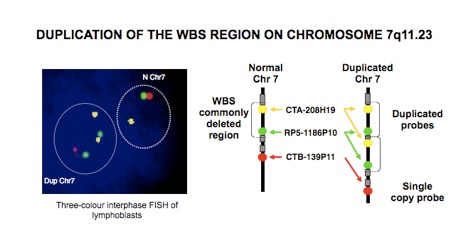7q11.23 Duplication Syndrome



Duplication of the WBS region was first identified in 2005 and since then, more than 30 cases have been reported. In contrast to people with deletion of 7q11.23 (those with Williams-Beuren syndrome), people with duplication of 7q11.23 have relatively intact visuo-spatial skills but almost all have some form of speech and language impairment. A subtle, but recognizable facial phenotype consisting of a high broad nose, posteriorly rotated ears, high arched palate, short philtrum and thin upper lip is also seen.
There is a strong genetic component to language impairment, but so far only the transcription factor FOXP2 has been implicated in its etiology, and only in a few cases. The identification of a second locus associated with language impairment is therefore unexpected, and opens up the possibility of linking the expressive language phenotype to a specific gene (or genes) from within the WBS region.

To unravel the molecular basis of speech and language impairment in 7q11.23 duplication syndrome we are using mouse models with additional copies of genes from the region.
We are also recruiting participants with molecular or clinical evidence of a 7q11.23 duplication to try to correlate genotype and phenotype in this group of individuals. Please contact Lucy Osborne for further information and see the Clinical Research Studies page for the appropriate family information sheet and consent forms.
Mouse Model Collaborators:
Toronto Centre for Phenogenomics
John Yeomans (University of Toronto)
Clinical Collaborators:
Janis Oram-Cardy (University of Western Ontario)
Colleen Morris (University of Nevada)
Carolyn Mervis (University of Louisville)
Steve Scherer (Hospital for Sick Children, Toronto)
Karen Gripp (Alfred I. Dupont Hospital for Children, Delaware)
Barbara Pober (Massachusetts General Hospital, Boston)